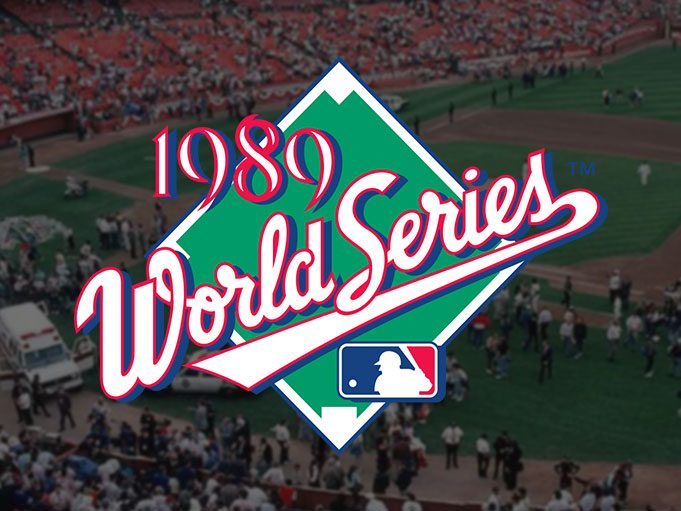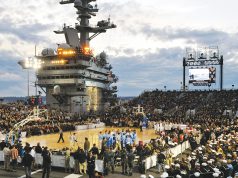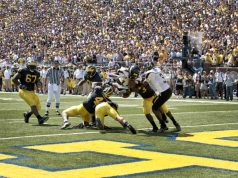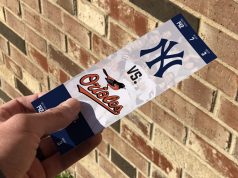When the 1989 San Francisco quake hit, baseball stopped as a city tended to its wounds. It was the only time in history a World Series was interrupted for anything other than inclement weather.
The baseball field came to life under Al Clark’s feet. Halfdressed and perplexed, Clark stood in the middle of San Francisco’s Candlestick Park and watched the tranquil, well-groomed blades of grass rise and fall like an angry ocean tide.
It was 5:04 p.m. PDT on Oct. 17, 1989, and Clark, then an AL umpire, was 21 minutes from working game three of the 86th World Series — featuring the San Francisco Giants and Oakland Athletics — when Mother Nature flexed her muscles, ravaging the Bay area with an earthquake that measured 7.1 on the Richter scale.
“I saw the field at Candlestick in an actual water wave. I saw the earth swell,” Clark, 53, recalls. “We were sitting around the dressing room preparing to work a World Series ballgame. All of a sudden, we heard a loud roar that sounded like a locomotive.
“There was a vibration that went through the dressing room. I had shower shoes, long johns and a long-sleeved shirt on, and I ran directly onto the field. Not knowing if the walls were going to come crumbling down, the safest place was on the field.”
Those viewing the nationally televised game from their living rooms heard ABC sports announcer Al Michaels utter the disconcerting cliffhanger, “There’s an earth …” before the picture suddenly went black.
The tremor shattered windows, violently shook the stadium along with the 60,000-plus fans in attendance and, in the end, killed 67 people in other parts of the city and caused billions of dollars worth of damage to the area. Then-MLB Commissioner Fay Vincent made the decision in conjunction with city, stadium and other baseball officials to postpone the Series for 10 days — the only time a series has been interrupted for anything other than inclement weather.
Vic Voltaggio, the AL umpire scheduled to work the plate that day, sat in a locker room directly across the hall from Clark when he was knocked off a bench by the quake, which lasted 15 seconds and was felt as far south as San Diego.
“I had just finished talking to Fay Vincent,” said Voltaggio. “He had come into the locker room with his entourage. After he left, (ESPN analyst Chris Berman) came in and spent a few minutes. He left, and I was in there by myself when it hit. The walls were waving. It was almost like an optical illusion.”
Players, coaches and the media joined Clark, Voltaggio and the four other umpires — Eric Gregg, Rich Garcia, Paul Runge and Dutch Rennert — on the field. A squadron of police cars streamed onto the baseball diamond to assess the damage and keep fans off the field. Players scanned the bleachers for their wives and children, waving them down. After the immediate danger passed, fans cheered wildly amid the chaos.
“There was a lot of commotion,” said Voltaggio, who retired in 1995 with a pair of bad knees after 24 years in the majors. “Within about a half-hour, it was almost a carnival-type atmosphere. I don’t think (the fans) really knew the extent of damage.”
The Giants entered the game trailing the Series, 2-0. “The people in the stands thought this was an omen to turn the World Series around,” recalled Clark.
The police officers — 70 in all — attempted to flush the fans from the stadium. The applause abruptly halted when word of the ever-increasing death count spread like a brushfire through the crowd. Clumps of strangers huddled around portable television sets to watch live news reports at sites like the San Francisco-Oakland Bay Bridge, which partially collapsed.
“There was stunned silence from everyone in the stadium when they realized this was a very serious situation,” Clark said.
Around 7:00 p.m., the stadium had all but emptied. Voltaggio had retired to a nearby hotel, but Clark, who had altered his original plan of spending the night in the umpire’s dressing room, was arranging for some emergency communication.
“I saw that ESPN was still telecasting — their trucks had their own generators,” said Clark. “I went up to one of the producers and told them I would go on their broadcast and talk about the situation if they would let me use their phone to call my wife (Diane) in Pennsylvania.”
The producer obliged, and Clark provided ESPN with a few sound bites before negotiating his way to a hotel under a blanket of darkness in a city devoid of electricity. Once the airport re-opened two days later, Clark flew home to Newton, Pa., to await further instructions.
Voltaggio, unlike Clark, had most of his immediate family in town for the Series and stayed to witness the aftermath. “It was a strange situation,” said Voltaggio, 60. “You’re walking along the city filled with broken glass. A lot of the windows had been broken. I’m sure there was a certain amount of looting, so you really had to take care of yourself. My wife (Janet) had this little flashlight in her pocketbook, and we used that to get (around).”
The debate about whether to resume, cancel or relocate the World Series became a moral — and safety — issue embraced by the nation. Many called for the cancellation of the Series, claiming San Francisco needed time to recuperate and mourn its dead. Remarkably though, Bay area residents were eager to restart.
“I think most people thought they were going to cancel the World Series,” said Voltaggio, now a resident of Spring Hill, Fla. “By and large, that’s what the attitude was. But I think the people of San Francisco wanted it to continue, almost as a healing project.”
Twelve days after game two, on Oct. 29, the World Series continued after a team of 17 structural engineers and two architects deemed Candlestick Park structurally sound, stating most of the damage was “cosmetic.” Vincent also paused for approval from the community and police force before commencing the Series.
“Fay Vincent did an absolutely fabulous job putting baseball on the back burner and allowing the Bay area to settle itself,” Clark said. “He was masterful in his thought process of waiting and deciding not to move the Series.”
Oakland needed only two more games to clinch the Series in a straight sweep, and respectfully refrained from locker room celebrations. Oakland ace Dave Stewart became the first pitcher in history to collect two victories in the same season in the League Championship Series and World Series, and the Athletics finally realized their potential as one of the finest teams of that era. But it was an unlikely participant that monopolized the newspaper headlines.
“I’ll tell people that I worked the Earthquake Series and they don’t remember who was playing,” said Rennert, 69, and now retired. “But they always remember the quake. It was a big-league quake. And let’s face it: It was only a baseball game.”
What's Your Call? Leave a Comment:
Note: This article is archival in nature. Rules, interpretations, mechanics, philosophies and other information may or may not be correct for the current year.
This article is the copyright of ©Referee Enterprises, Inc., and may not be republished in whole or in part online, in print or in any capacity without expressed written permission from Referee. The article is made available for educational use by individuals.



















